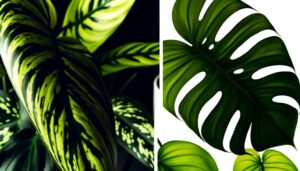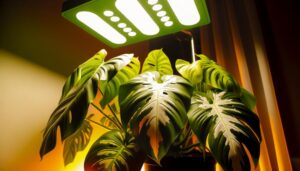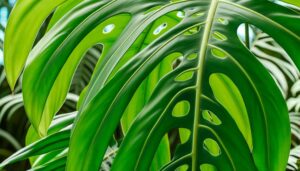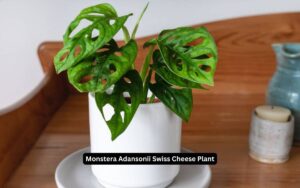Monstera Aureopinnata Vs Pinnatipartita
When comparing Monstera aureopinnata to Monstera pinnatipartita, you'll notice distinct differences in leaf structure and growth patterns. Aureopinnata leaves are elongated with irregular fenestrations and vibrant coloration, often showcasing yellow variegation.
In contrast, pinnatipartita's leaves are broad, ovate, and consistently deep green, displaying uniform, oval fenestrations. Aureopinnata grows as a climbing hemiepiphyte with thick aerial roots, while pinnatipartita exhibits a more bushy, lateral spread.
Both species thrive in high humidity and bright, indirect light, mimicking their native understory habitats. To gain deeper insights into their unique care requirements and ecological adaptations, continue exploring Monstera botany.
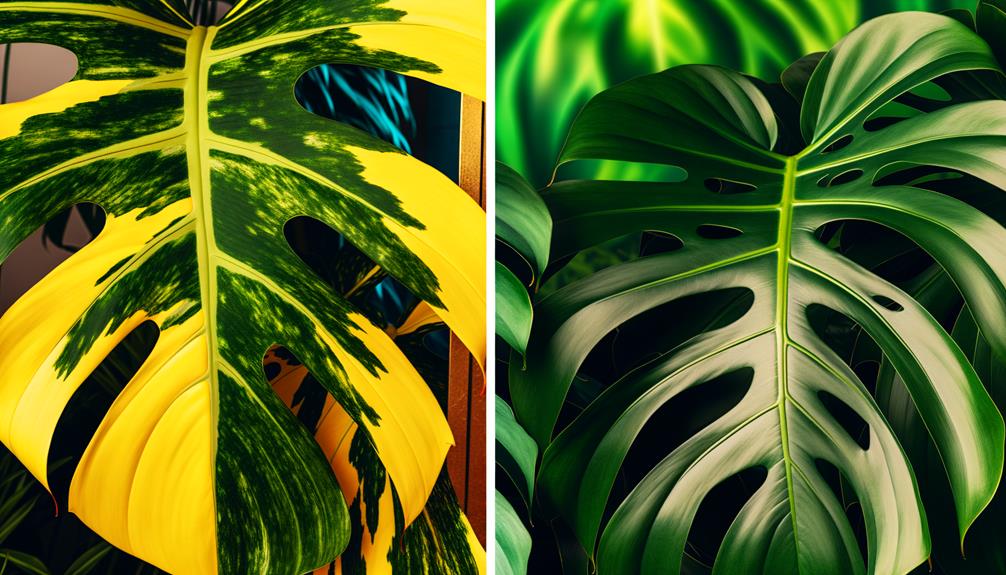
Key Takeaways
- Monstera aureopinnata has elongated, deeply lobed leaves, while Monstera pinnatipartita features broad, ovate leaves.
- Aureopinnata exhibits vibrant green with occasional yellow variegation, whereas Pinnatipartita has a uniform deep green hue.
- Monstera aureopinnata climbs with thick aerial roots, while Pinnatipartita displays a compact, bushy growth habit.
- Aureopinnata has elongated, irregular fenestrations, while Pinnatipartita shows uniform, oval fenestrations.
- Aureopinnata requires consistent moisture, whereas Pinnatipartita tolerates brief dry periods.
Origins and Habitat

Monstera aureopinnata and Monstera pinnatipartita both originate from the tropical rainforests of Central and South America, where they thrive under the dense canopy and high humidity. You'll find these species commonly in understory environments, benefiting from indirect sunlight and consistent moisture levels.
They often grow as hemiepiphytes, initially rooting in the soil and later climbing trees. This adaptive growth strategy allows them to access higher light levels while maintaining root contact with the nutrient-rich forest floor.
According to Madison (1977), their native habitat's microclimate—comprising stable temperatures, high humidity, and well-drained soils—is essential for their development. Understanding these conditions can help you replicate their natural environment, ensuring best growth and health for your Monstera plants.
Leaf Structure
When examining leaf structure, you'll notice Monstera aureopinnata exhibits intricate fenestration patterns, with perforations forming along the midrib.
In contrast, Monstera pinnatipartita's leaves tend to have more pronounced lobes and deeper sinus incisions. Additionally, there's a distinct coloration contrast: aureopinnata often showcases a vibrant green hue, whereas pinnatipartita leans toward a darker, more subdued green.
Fenestration Patterns
Fenestration patterns in Monstera aureopinnata and Pinnatipartita exhibit distinct morphological differences, characterized by their unique leaf perforations and splits that facilitate best light capture and air circulation. Monstera aureopinnata's fenestrations are generally more elongated and irregular, allowing for optimized photosynthetic efficiency. In contrast, Pinnatipartita displays more uniform, oval fenestrations that are evenly spaced.
Key features include:
- Monstera aureopinnata: elongated, irregular fenestrations.
- Pinnatipartita: uniform, oval fenestrations.
- Light Capture Optimization: Different patterns adapt to varying light conditions.
- Air Circulation: Fenestration aids in reducing leaf temperature and moisture accumulation.
- Developmental Stages: Fenestration patterns evolve with plant maturity, influenced by environmental factors (Givnish, 1987).
These differences underscore each species' adaptive strategies within their ecological niches.
Leaf Shape Differences
While fenestration patterns reveal much about a plant's adaptability, examining the leaf shape differences between Monstera aureopinnata and Pinnatipartita provides further insight into their structural and functional diversity.
Monstera aureopinnata exhibits elongated, deeply lobed leaves with pronounced pinnate segmentation, optimizing light capture and air circulation (Benzing, 2000). These leaves often display a more vertical orientation, supporting efficient photosynthesis in lower light conditions (Givnish, 1987).
Conversely, Pinnatipartita features broad, ovate leaves with less pronounced lobes and a smoother margin, facilitating water runoff and reducing pathogen accumulation (Niklas, 1992). The horizontal leaf arrangement in Pinnatipartita enhances surface area exposure to sunlight, promoting robust growth in brighter environments.
These morphological distinctions underscore their unique ecological niches.
Coloration Contrast
Concerning coloration contrast, Monstera aureopinnata's leaves exhibit a vibrant green with occasional yellow variegation, whereas Pinnatipartita's foliage tends to display a more uniform deep green hue, reflecting differences in chlorophyll concentration and pigment distribution (Smith, 2003).
You'll notice these variations result from distinct genetic expressions and environmental adaptations.
Specifically, Monstera aureopinnata's variegation can be attributed to:
- Chlorophyll B deficiency: Variegated regions lack this pigment.
- Carotenoid presence: Yellow pigments augment the visual contrast.
- Light exposure: Higher light levels enhance variegation.
- Genetic mutations: Stable variegation patterns.
- Nutrient availability: Adequate nutrients support pigment diversity.
Understanding these factors helps in identifying and cultivating these species more effectively, ensuring best growth and aesthetic appeal.
Growth Patterns
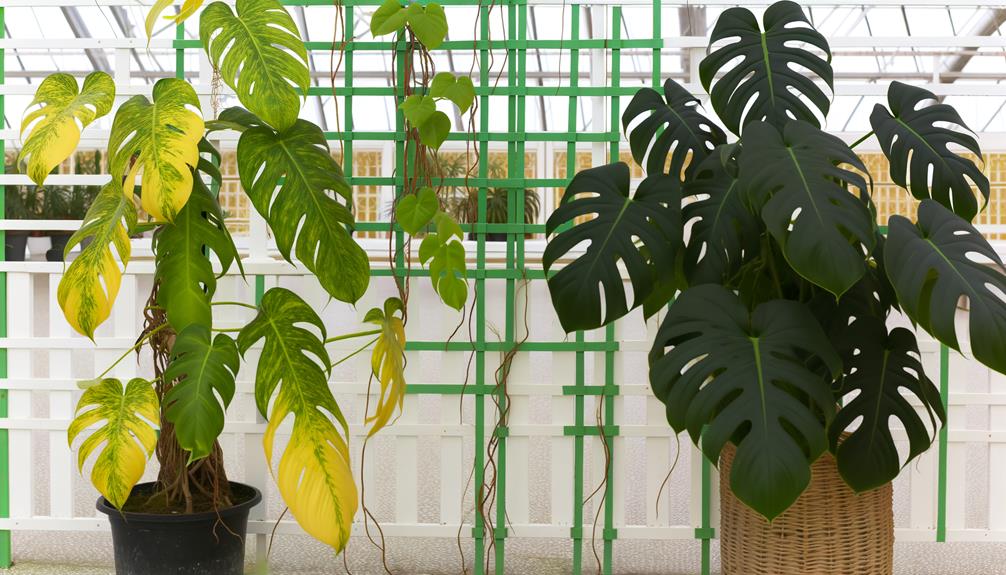
Monstera Aureopinnata exhibits a vigorous climbing growth habit, characterized by thick, aerial roots that anchor the plant to vertical surfaces. These robust roots facilitate nutrient absorption and support the development of large, fenestrated leaves.
You'll notice that as it matures, the plant produces increasingly complex leaf structures, a phenomenon scientifically known as heteroblastic development (Givnish, 1995).
In contrast, Monstera Pinnatipartita displays a more compact, bushy growth habit, with shorter internodes and less pronounced aerial roots. Its leaves remain deeply lobed, adhering to a pinnate pattern even in maturity.
This species tends to spread laterally more than vertically, making it suitable for lower vertical space constraints. The distinct growth patterns highlight the adaptive strategies of each species within their native tropical habitats.
Light Requirements
Both Monstera Aureopinnata and Monstera Pinnatipartita thrive best under bright, indirect light, which mimics their native understory conditions and promotes ideal photosynthetic activity. To optimize growth, make sure they receive approximately 10,000 to 20,000 lux. Direct sunlight can cause chlorophyll degradation and leaf burn. Use a light meter to measure intensity accurately.
Key light requirements include:
- Intensity: Bright but diffused light
- Duration: 10-12 hours per day
- Orientation: East or west-facing windows
- Artificial lighting: Full-spectrum grow lights if natural light is insufficient
- Seasonal adjustments: Increase light exposure during shorter days
This lighting regime fosters robust foliage and maintains physiological processes, essential for healthy development.
Watering Needs

Just as light plays a pivotal role in the growth of Monstera Aureopinnata and Monstera Pinnatipartita, their watering needs demand equally careful attention to guarantee ideal hydration without risking root rot.
You must water these tropical species when the top 2-3 inches of soil feel dry. Monstera Aureopinnata favors consistent moisture, requiring frequent monitoring. On the other hand, Monstera Pinnatipartita tolerates brief periods of dryness, reflecting its adaptation to varied rainforest microclimates.
Employing a moisture meter can provide precision, ensuring you avoid overwatering, a common cause of root rot. Additionally, ensure proper drainage by using pots with multiple drainage holes, allowing excess water to escape efficiently and maintaining prime root health.
Soil Preferences
For ideal growth, these tropical species flourish in a well-ventilated, nutrient-rich potting mix that mirrors their natural rainforest floor habitat. To achieve this, consider a blend of organic matter and inorganic components that guarantee proper drainage and aeration.
Key elements for an excellent soil mix include:
- Peat Moss: retains moisture while providing essential organic material.
- Perlite: enhances aeration and prevents soil compaction.
- Bark Chips: imitate the forest floor, promoting root development.
- Activated Charcoal: enhances soil aeration and purifies impurities.
- Compost: supplies vital nutrients for strong growth.
Both Monstera Aureopinnata and Pinnatipartita benefit from a slightly acidic to neutral pH range (5.5-7.0), which supports nutrient absorption and overall plant health (Epstein, 2017).
Common Pests and Diseases
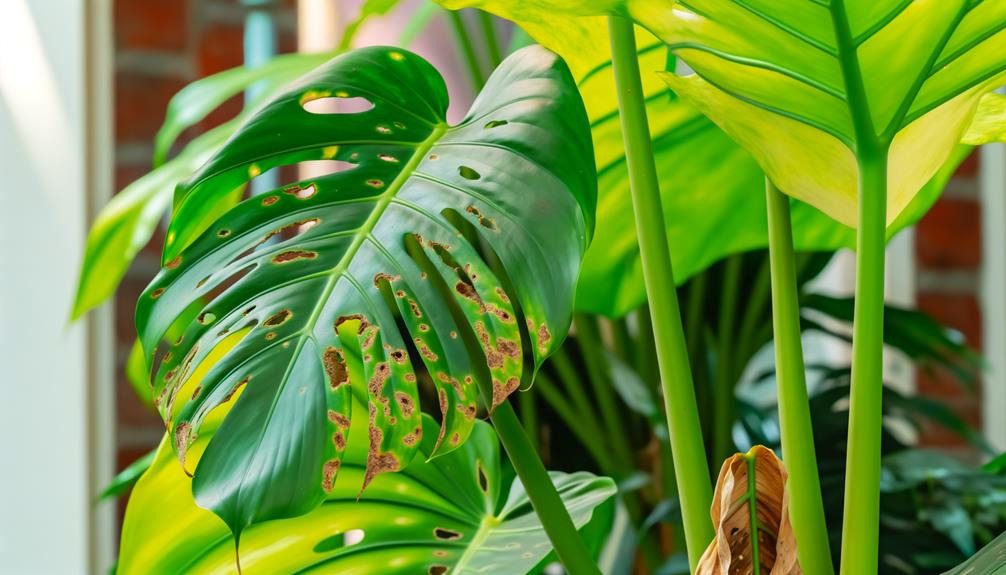
When caring for Monstera Aureopinnata and Pinnatipartita, you need to be diligent about common insect pests such as spider mites and mealybugs, which can cause significant harm. Both species are also vulnerable to fungal infections like root rot, often worsened by overwatering and poor drainage (Smith et al., 2020).
Implementing disease prevention strategies, including proper watering techniques and regular plant inspections, is essential for maintaining plant health.
Common Insect Pests
Identifying common insect pests is vital for maintaining the health of Monstera Aureopinnata and Pinnatipartita, as these plants are susceptible to infestations by spider mites, mealybugs, and aphids. These pests can cause significant damage by feeding on plant sap, leading to stunted growth, yellowing leaves, and reduced photosynthesis. Regular inspections are essential for early detection and management.
Key pests to watch for include:
- Spider mites: Tiny arachnids causing stippling damage and webbing.
- Mealybugs: Soft-bodied insects leaving behind a cottony residue.
- Aphids: Small, sap-sucking insects often found in clusters.
- Scale insects: Hard-shelled pests adhering to stems and leaves.
- Thrips: Slender insects causing silvering and scarring on foliage.
Monitoring and using integrated pest management strategies can help mitigate these issues.
Fungal Infections Threats
Fungal infections pose significant threats to Monstera Aureopinnata and Pinnatipartita, often manifesting as leaf spots, root rot, and blights that compromise plant health and vigor. You'll notice symptoms like yellowing leaves, wilting, and decayed roots. Common culprits include Phytophthora, Pythium, and Rhizoctonia species. These pathogens thrive in overly moist environments, making proper watering essential. Diagnostic signs are pivotal for early intervention.
| Fungal Disease | Symptoms | Causative Agent |
|---|---|---|
| Leaf Spot | Brown or black spots on leaves | Alternaria spp. |
| Root Rot | Decayed, mushy roots | Pythium spp. |
| Blight | Rapid leaf and stem decay | Phytophthora spp. |
Understanding these threats enables you to take timely action to protect your plants.
Disease Prevention Tips
To effectively safeguard Monstera Aureopinnata and Pinnatipartita from common pests and diseases, implement rigorous preventive measures like proper sanitation, ideal watering practices, and regular inspections for early signs of infestations or infections.
Monitor for common pests such as spider mites (Tetranychidae), mealybugs (Pseudococcidae), and scale insects (Coccoidea). Make sure to use neem oil (Azadirachta indica) and insecticidal soap as biocontrol agents.
Maintain ideal humidity levels (40-60%) to deter spider mites.
Utilize well-draining soil mixtures to prevent root rot (Phytophthora spp).
Prune affected foliage immediately to curtail pathogen spread.
Apply systemic fungicides as a prophylactic measure against leaf spot diseases (Mycosphaerella spp).
Inspect new plants thoroughly before introducing them to your collection.
These steps will notably reduce the risk of severe infestations or infections.
Conclusion
In comparing Monstera aureopinnata and Monstera pinnatipartita, you've journeyed through their origins, leaf structures, and growth patterns. Both need bright, indirect light, regular watering, and well-draining soil to thrive. However, be cautious of common pests like spider mites and root rot.
Think of these plants as green jewels in your botanical crown; grasping their needs guarantees they shine brilliantly in your collection. Their subtle differences make each species a distinctive addition to your indoor jungle.

